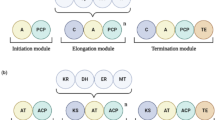Abstract
The aim of this study was to evaluate 54 lactic acid bacteria (LAB) strains isolated from meat, fermented vegetables and dairy products for their capacity to produce antimicrobial activities against several bacteria and fungi. The strain designed TN635 has been selected for advanced studies. The supernatant culture of this strain inhibits the growth of all tested pathogenic including the four Gram-negative bacteria (Salmonella enterica ATCC43972, Pseudomonas aeruginosa ATCC 49189, Hafnia sp. and Serratia sp.) and the pathogenic fungus Candida tropicalis R2 CIP203. Based on the nucleotide sequence of the 16S rRNA gene of the strain TN635 (1,540 pb accession no FN252881) and the phylogenetic analysis, we propose the assignment of our new isolate bacterium as Lactobacillus plantarum sp. TN635 strain. Its antimicrobial compound was determined as a proteinaceous substance, stable to heat and to treatment with surfactants and organic solvents. Highest antimicrobial activity was found between pH 3 and 11 with an optimum at pH = 7. The BacTN635 was purified to homogeneity by a four-step protocol involving ammonium sulfate precipitation, centrifugal microconcentrators with a 10-kDa membrane cutoff, gel filtration Sephadex G-25, and C18 reverse-phase HPLC. SDS-PAGE analysis of the purified BacTN635, revealed a single band with an estimated molecular mass of approximately 4 kDa. The maximum bacteriocin production (5,000 AU/ml) was recorded after a 16-h incubation in Man, Rogosa, and Sharpe (MRS) medium at 30 °C. The mode of action of the partial purified BacTN635 was identified as bactericidal against Listeria ivanovii BUG 496 and as fungistatic against C. tropicalis R2 CIP203.






Similar content being viewed by others
References
Alisky, J., Iczkowski, K., Rapoport, A., & Troitsky, N. (1998). Journal of Infection, 36, 5–15.
Macfarlane, G. T., & Cummings, J. H. (2002). Current Opinion in Infectious Diseases, 15, 501–506.
Papagianni, M. (2003). Biotechnology Advances, 21, 465–499.
Twomey, D., Ross, R. P., Ryan, M., Meaney, B., & Hill, C. (2002). Antonie Van Leeuwenhoek, 82, 165–18.
Brooks, G. F., Butel, J. S., & Morse, S. A. (1998). Jawetz, Melnick, and Adelberg’s medical microbiology (p. 269). Upper Saddle River, New Jersey, USA: Appleton & Lange.
Settanni, L., & Corsetti, A. (2008). International Journal of Food Microbiology, 121, 123–138.
Nawaz, S. K., Riaz, S., Riaz, S., & Hasnain, S. (2009). African. J. Biotechnol., 8, 365–368.
Hammami, I., Rhouma, A., Jaouadi, B., Rebai, A., & Nesme, X. (2009). Letters in Applied Microbiology, 48, 253–260.
Diop, M. B., Dubois-Dauphin, R., Tine, E., Ngom, A., Destain, J., & Thonart, P. (2007). Biotechnology, Agronomy, Society and Environment, 11, 275–281.
Paul, R. R., Morgan, S., & Hill, C. (2002). International Journal of Food Microbiology, 79, 3–16.
Messi, P., Bondi, M., Sabia, C., Battini, R., & Manicardi, G. (2001). International Journal of Food Microbiology, 64, 193–198.
Todorov, S. D., & Dicks, L. M. (2004). Journal of Basic Microbiology, 44, 305–316.
Todorov, S. D., & Dicks, L. M. (2005). Enzyme and Microbial Technology, 36, 318–326.
Todorov, S. D., Nyati, H., Meincken, M., & Dicks, L. M. T. (2007). Food Control, 18, 656–664.
Hanahan, D. (1983). Journal of Molecular Biology, 16, 557–580.
Janssen, G. R., & Bibb, M. J. (1993). Gene, 124, 133–134.
Sambrook, J., Fritsch, E. F., & Maniatis, T. (1989). Molecular cloning: a laboratory manual (2nd ed.). New York: Cold Spring Harbor Laboratory Press.
Leenhouts, K. J., Kok, J., & Venema, G. (1990). Applied and Environmental Microbiology, 56, 2726–2735.
Lee, C. M., Sieo, C. C., Abdullah, N., & Ho, Y. W. (2008). FEMS Microbiology Letters, 287, 136–141.
Thompson, J. D., Higgins, D. G., & Gibson, T. J. (1994). Nucleic Acids Research, 22, 4673–4680.
Felsenstein, J. (1989). PHYLIP-Phylogeny Inference Package, version 3.2. Cladistics, 5, 164–166.
Saitou, N., & Nei, M. (1987). Molecular Biology and Evolution, 4, 406–425.
Tagg, J. R., & McGiven, A. R. (1971). Applied Microbiology, 21, 943.
Laemmli, U. K. (1970). Nature, 227, 680–685.
Bradford, M. M. (1976). Analytical Biochemistry, 72, 248–254.
Karunasagar, I., Krohne, G., & Goebel, W. (1993). Infection and Immunity, 61, 162–169.
Atanassova, V., Meindl, A., & Ring, C. (2001). International Journal of Food Microbiology, 68, 105–113.
Aktypis, A., Kalantzopoulos, G., Huis IN’T Veld, J. H. J., & Ten Brink, B. (1998). Journal of Applied Microbiology, 84, 568–576.
Lavermicocca, P., Valerio, F., Evidente, A., Lazzaroni, S., Corsetti, A., & Gobbetti, M. (2000). Applied and Environmental Microbiology, 66, 4084–4090.
Atanassova, M., Choiset, Y., Dalgalarrond, D., Chobert, J. M., Dousset, X., Ivanova, I., et al. (2003). International Journal of Food Microbiology, 8, 63–73.
Erich, L., & Martin, J. (1997). Antimicrobial food additives, characteristics, uses, effects (2nd Ed.). Translated by S.F. Laichena Berlin: Springer.
Wiblin, R. T. (1997). Nosocomial pneumonia. In R. P. Wenzel (Ed.), Prevention and control of nosocomial infections (3rd ed., pp. 807–819). Baltimore: Williams and Wilkins.
Kobayashi, H., Matsuda, K., Ikeda, T., Suzuki, M., Takahashi, S., Suzuki, A., et al. (1994). Infection and Immunity, 62, 615–622.
Acknowledgments
This work was supported by the Tunisian government (Contract Program CBS-LEMP) and the CMCU project (2006-2008) No 06/S 0901 “MELLOULI/AIGLE”. We are grateful to Dr. M. Ferchichi for providing the indicator bacteria.
Author information
Authors and Affiliations
Corresponding author
Rights and permissions
About this article
Cite this article
Smaoui, S., Elleuch, L., Bejar, W. et al. Inhibition of Fungi and Gram-Negative Bacteria by Bacteriocin BacTN635 Produced by Lactobacillus plantarum sp. TN635. Appl Biochem Biotechnol 162, 1132–1146 (2010). https://doi.org/10.1007/s12010-009-8821-7
Received:
Accepted:
Published:
Issue Date:
DOI: https://doi.org/10.1007/s12010-009-8821-7




